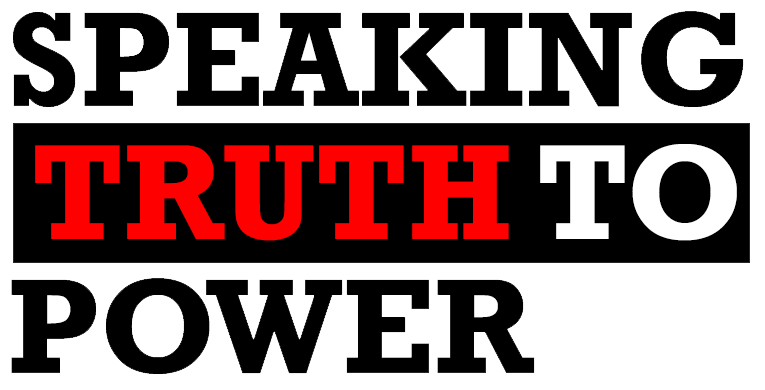
The concept of “speaking truth to power” likely originated as grunts, growls, and other utterances long ago before the development of speech. Regardless of the form it takes, speaking truth to power -whether they are parents, partners, persons above you in your organization, peers, personnel, patients, or providers – should be thoughtful and based on the goal of informing the recipients of your message about a point of view that you believe should be considered. Depending upon your relationship with the recipient(s), speaking truth to power can be daunting. Even as I age, there are many times when it takes deliberate effort to muster the courage to speak up and to speak out. Regardless of the response, I usually, but not always, feel a sense of relief after speaking out.
Though I listed them separately, the power dynamic is crucial when speaking truth to anyone on the list above. As you’re interacting with others, keep in mind the old phrase that was uttered and popularized by Spider-Man’s uncle, “With great power comes great responsibility.” I assert that regardless of its magnitude, we all have power and should wield it judiciously.
I frequently advise people who are sharing their point of view or challenging someone else’s point of view to drop declarative statements in lieu of interrogatives. It’s particularly important when the power dynamic tilts in your favor. In almost all situations, understanding the other party’s point of view provides insights that you might not have considered as you formulate the message you want to deliver. Ask why and how. Oftentimes, a change of mind occurs when someone reviews and speaks aloud the logic behind their point of view – sometimes, their opinion; sometimes mine. In either case, the outcome will likely improve. This can be particularly important with partners both personal and professional regardless of setting.
When speaking as a leader to new personnel in my reporting structure, I very consistently suggested that “I wanted to be treated with a certain amount of disrespect.” After the initial look of surprise, I reminded them that I had only one point of view and regardless of my title or authority that hearing their point of view would only increase our chances for mutual understanding and success. In new situations, it takes time to earn the trust necessary to change the culture – months and years, not days or weeks. It’s difficult and critically important that all managers and employees in the organizational structure adopt that approach. This radically improves participation in meetings – formal or informal, one-on-one or in groups.
For patients, their families, physicians, and other providers, it is more important than ever to speak truth. My father, a wonderful and popular physician, said that the greatest challenge of his job was getting at facts – getting people to trust him. Please remember that many patients and families lose their sense of control as they interact with members of the care delivery team. They are often intimidated by the highly educated professionals who care for them. Caregivers do well when they seek to understand the aspirations of the patients and families with whom they interact.
My realization of the power that we place in caregivers became only too apparent when I was listening as a family member to a cardiologist discuss my father’s heart attack in the cardiology waiting room with my mother. After he left, we revisited every word and every facial expression. He had frowned a couple of times. Was that concern for my father or because he was having a bad day? My mother grew up as did most of us believing that it was disrespectful to question a caregiver. Fortunately, changes are coming. “Get a second opinion” has become an often-heard recommendation.
As with any sector, healthcare has a power hierarchy. It should have a common goal –do whatever is best for our patients and populations. In the past, challenging the judgment of someone in the hierarchy above you took courage. That is improving but not fast enough. No caregiver has a complete view of experience with all the processes and technologies it takes to promote health and deliver care. To be an effective team, trust, understanding, and open communication are critical. Kindness and compassion are the essential elements of caring. Showing them in interactions with coworkers is as important as showing them to patients and families.
Patients and families are a special case. They place a sacred trust in providers that must be honored and protected. When talking to patient and families, treat them respectfully. Encourage questions. Answer diplomatically but honestly and fully. Remember that most people – patients and families – are under stress and unable to process communications as well as when they’re comfortable. We all know that bad news can put the recipients into a state of shock. Communicate clearly. Give them time to absorb the news. Be quiet – don’t be afraid of the silence while they process bad news. Use whatever medium – paper-based or digital – they prefer written plainly in their language of choice with minimal medical jargon so they can revisit what you said when you leave them. Then, most importantly, test the patient and family for comprehension. Repeat if necessary until they do understand. Share your logic and your point of view. Consider theirs. Healthcare is a series of choices that ultimately belong to the patient and family. Be aware of your power. Use it wisely and compassionately. Develop and then follow a personalized plan of care.
Speaking truth to power is essential. Speaking with truth from a position of power is also essential. Only through honest, respectful, open, and understandable communication can we achieve the optimal outcomes as individuals, families, communities, and societies.
